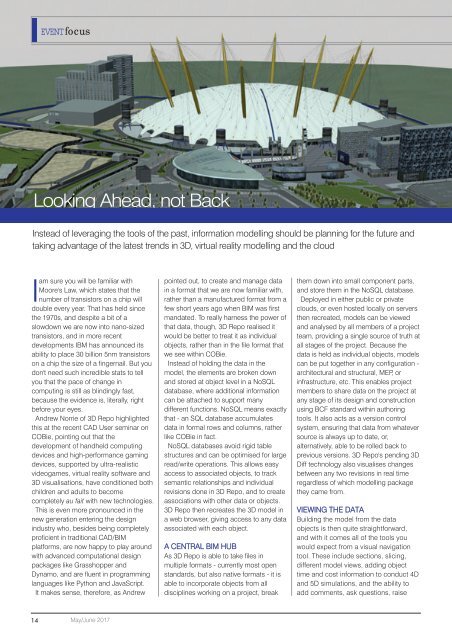You also want an ePaper? Increase the reach of your titles
YUMPU automatically turns print PDFs into web optimized ePapers that Google loves.
EVENTfocus<br />
Looking Ahead, not Back<br />
Instead of leveraging the tools of the past, information modelling should be planning for the future and<br />
taking advantage of the latest trends in 3D, virtual reality modelling and the cloud<br />
Iam sure you will be familiar with<br />
Moore's Law, which states that the<br />
number of transistors on a chip will<br />
double every year. That has held since<br />
the 1970s, and despite a bit of a<br />
slowdown we are now into nano-sized<br />
transistors, and in more recent<br />
developments IBM has announced its<br />
ability to place 30 billion 5nm transistors<br />
on a chip the size of a fingernail. But you<br />
don't need such incredible stats to tell<br />
you that the pace of change in<br />
computing is still as blindingly fast,<br />
because the evidence is, literally, right<br />
before your eyes.<br />
Andrew Norrie of 3D Repo highlighted<br />
this at the recent CAD User seminar on<br />
COBie, pointing out that the<br />
development of handheld computing<br />
devices and high-performance gaming<br />
devices, supported by ultra-realistic<br />
videogames, virtual reality software and<br />
3D visualisations, have conditioned both<br />
children and adults to become<br />
completely au fait with new technologies.<br />
This is even more pronounced in the<br />
new generation entering the design<br />
industry who, besides being completely<br />
proficient in traditional CAD/BIM<br />
platforms, are now happy to play around<br />
with advanced computational design<br />
packages like Grasshopper and<br />
Dynamo, and are fluent in programming<br />
languages like Python and JavaScript.<br />
It makes sense, therefore, as Andrew<br />
pointed out, to create and manage data<br />
in a format that we are now familiar with,<br />
rather than a manufactured format from a<br />
few short years ago when BIM was first<br />
mandated. To really harness the power of<br />
that data, though, 3D Repo realised it<br />
would be better to treat it as individual<br />
objects, rather than in the file format that<br />
we see within COBie.<br />
Instead of holding the data in the<br />
model, the elements are broken down<br />
and stored at object level in a NoSQL<br />
database, where additional information<br />
can be attached to support many<br />
different functions. NoSQL means exactly<br />
that - an SQL database accumulates<br />
data in formal rows and columns, rather<br />
like COBie in fact.<br />
NoSQL databases avoid rigid table<br />
structures and can be optimised for large<br />
read/write operations. This allows easy<br />
access to associated objects, to track<br />
semantic relationships and individual<br />
revisions done in 3D Repo, and to create<br />
associations with other data or objects.<br />
3D Repo then recreates the 3D model in<br />
a web browser, giving access to any data<br />
associated with each object.<br />
A CENTRAL BIM HUB<br />
As 3D Repo is able to take files in<br />
multiple formats - currently most open<br />
standards, but also native formats - it is<br />
able to incorporate objects from all<br />
disciplines working on a project, break<br />
them down into small component parts,<br />
and store them in the NoSQL database.<br />
Deployed in either public or private<br />
clouds, or even hosted locally on servers<br />
then recreated, models can be viewed<br />
and analysed by all members of a project<br />
team, providing a single source of truth at<br />
all stages of the project. Because the<br />
data is held as individual objects, models<br />
can be put together in any configuration -<br />
architectural and structural, MEP, or<br />
infrastructure, etc. This enables project<br />
members to share data on the project at<br />
any stage of its design and construction<br />
using BCF standard within authoring<br />
tools. It also acts as a version control<br />
system, ensuring that data from whatever<br />
source is always up to date, or,<br />
alternatively, able to be rolled back to<br />
previous versions. 3D Repo's pending 3D<br />
Diff technology also visualises changes<br />
between any two revisions in real time<br />
regardless of which modelling package<br />
they came from.<br />
VIEWING THE DATA<br />
Building the model from the data<br />
objects is then quite straightforward,<br />
and with it comes all of the tools you<br />
would expect from a visual navigation<br />
tool. These include sections, slicing,<br />
different model views, adding object<br />
time and cost information to conduct 4D<br />
and 5D simulations, and the ability to<br />
add comments, ask questions, raise<br />
14<br />
May/June 2017

















